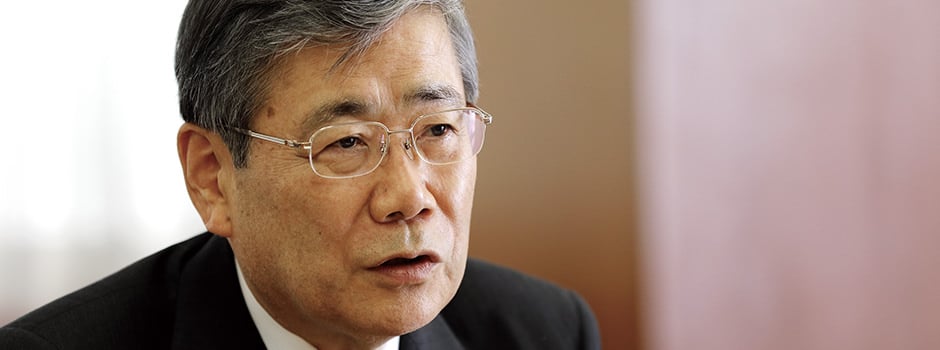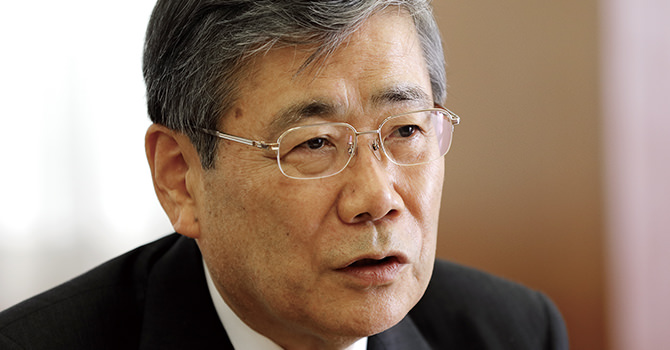PRESIDENT'S MESSAGE
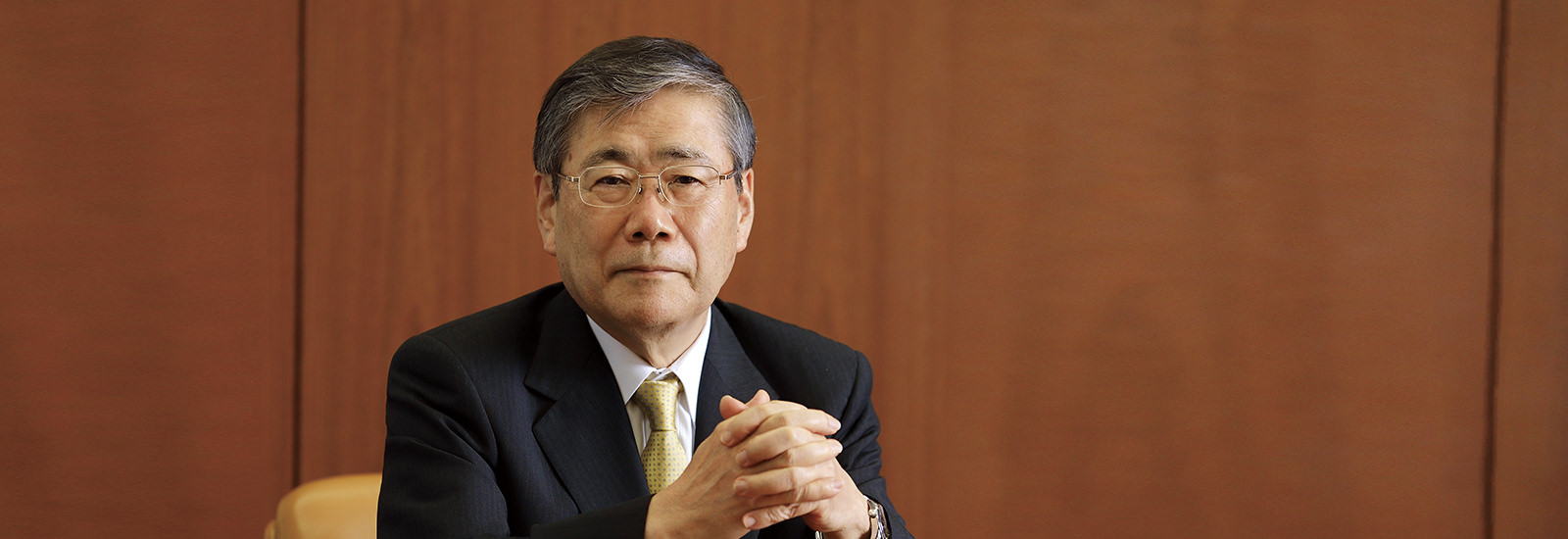
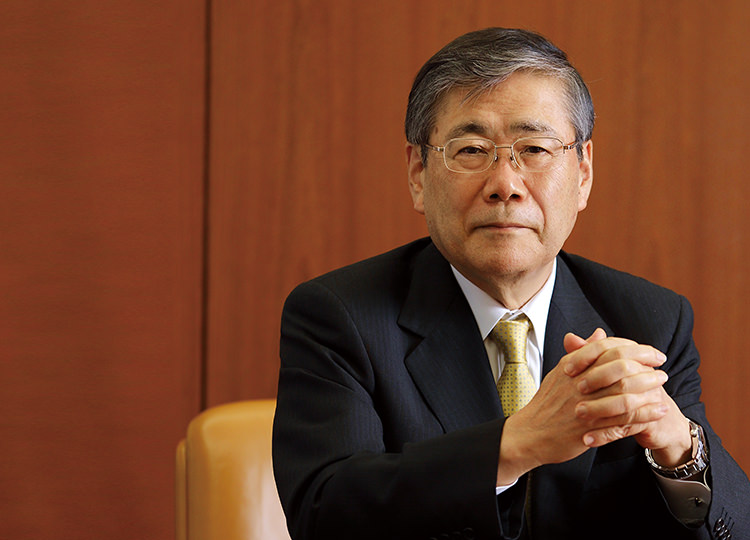
Review of the 2015 Medium-Term Business Plan:
Fiscal 2017 marked the end of our three-year Medium-Term Business Plan launched in fiscal 2015. Regrettably, the numerical targets we had set for business scale expansion and profitability enhancement went unachieved.
Our operating income worsened for two main reasons: deterioration of our business environment, particularly the thermal power systems market, and the MRJ's delayed development and increased development costs. In response we implemented a variety of measures, but improvement during the period of the 2015 Medium-Term Business Plan was rather limited. In retrospect we must recognize our shortcomings—including our inadequate resiliency to cope with these unanticipated turns of events and insufficient flexibility in planning.
Amid these adverse conditions, we did however achieve some targets and score some positive results. Through rigorous cash flow management, balance sheet improvement, and robust asset management, we continued to generate a robust free cash flow after absorbing the MRJ's development costs, the burden from the South Africa project, and outlays related to other issue-laden projects. In fiscal 2017 free cash flow reached ¥200 billion—the target we had set in our 2015 Medium-Term Business Plan. We also scored progress in reducing our interest-bearing debt and recorded a historically low debt/equity ratio of 38%, resulting in a solid financial foundation.
In addition, having learned the necessity of responses to challenges in our large-scale engineering business and new business areas, we focused on improving and reinforcing our risk management structure. The various business structure reforms we launched in earnest in our 2012 Medium-Term Business Plan, including corporate governance reforms, neared completion, clearly paving the way toward a new growth phase.
Key Business and Financial Results
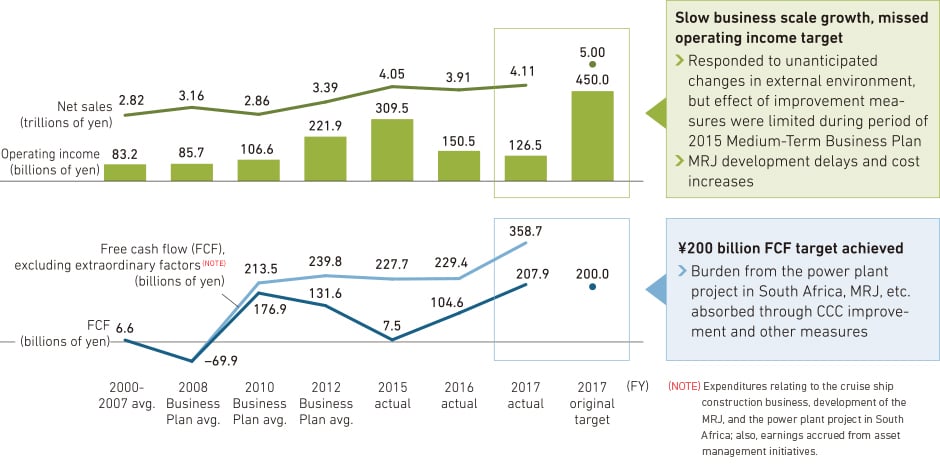
TOP Concept:
The history of humankind has been a progression from a lengthy period as an agrarian society to the industrial society that emerged after the Industrial Revolution. Today, society is once again in the throes of vast changes, this time caused by information and communication technologies, bringing us to the threshold of a new era—a “super-smart” era referred to in Japan as “Society 5.0.” Although machine-based industry, our sphere of excellence, won't lose its value going forward, the world of tomorrow will clearly see new levels of demand for information, services, and systems. Moreover, society today is advancing with ever-quickening speed, the environment undergoing transformations at a dizzying pace.
Starting from fiscal 2018, MHI Group is now pursuing a shift toward a more aggressive stance based on the management foundations we built up during the years of our 2015 Medium-Term Business Plan. To succeed, we will need to get a firm grasp on social changes expeditiously, and to respond continuously to the needs of both society and our stakeholders.
Toward achievement of those objectives, we have created a new management concept called “Triple One Proportion” (TOP). TOP's target is to achieve a favorable balance—in the form of a 1:1:1 ratio—between net sales, total assets, and market value. The concept, which evolved out of commonly shared social values such as the environmental, social, and governance (ESG) criteria and the United Nations' Sustainable Development Goals (SDGs), maintains keen cognizance of the needs of our customers, our investors, and MHI itself. We believe TOP will serve as a guidepost along the path toward reaching our next phase.


MHI FUTURE STREAM:
In order for MHI Group to remain an entity needed by society long into the future, it is vital that we provide the technologies and services required at each stage along the steady advance of society. Today, we consistently focus on projecting what society will need, what role we can play, and how we can contribute to society 10 or 20 years into the future. We ourselves must change accordingly.
To respond to evolutionary changes in society, clearly we must proactively incorporate cutting-edge technologies and expertise in areas such as IoT and AI. But at the same time, we must also pay close heed to matters including climate change, demographic trends, and shifts in industrial structure.
Earlier, in the days when Japan prospered on the strength of its steel and marine transport industries, MHI sustained growth, in tandem with Japan's economic development, by providing products and services to domestic customers. But with the rise of the emerging economies and developments in globalization, MHI's core markets shifted from Japan to other countries, thrusting MHI into a protracted period of sluggish performance.
Today, in some of our business areas—air-conditioning and refrigeration systems and turbochargers, for example—production is expanding outside Japan as the overseas markets become our main markets. Even so, we need to always give constant consideration to where society's needs are at present and how they are changing, and recalibrate our business portfolio continuously.
Recently, as a vision expressing our ongoing reform agenda toward realizing a sustainable planet, we have launched “MHI FUTURE STREAM.” Like a stream whose flow never ceases, our new concept embraces a spirit of sustained self-reinvention.
MHI possesses not only a wealth of diverse machine technologies but also a plethora of related elemental technologies accumulated through the years. In order for us to provide services matching the needs of the times, these various technologies must be adeptly combined, making full use of AI, IoT, and outside knowledge, to enable innovations that will lead to new areas of business.
In continuously taking up new challenges, obviously the outcome is at times success but at other times failure. Going forward, making active use of the knowhow in risk resilience that we have cultivated over the years, we will shun bold and reckless initiatives and instead pursue “controlled risk-taking” that will enable us to carry out carefully planned challenges.
With this “controlled risk-taking” in mind, by undertaking activities continuously with a spirit of entrepreneurship, I am confident that we can be reborn as an all-new type of machine manufacturer.
The 2018 Medium-Term Business Plan:
Now that our agenda of business structure reforms is near completion and the various issues we confronted in recent years have been addressed, we are ready to proceed to the next phase. We see the 2018 Medium-Term Business Plan—a three-year program commencing in fiscal 2018—as the new step toward putting MHI on a sustained growth path. Under this new plan we will take the business structure reforms implemented until now and apply them throughout our Group, and also drive our growth strategies forward, based on our Long- Term Vision, toward realizing a corporate structure having growth potential and sustainability on a global level.
Our numerical targets set for fiscal 2020(NOTE1) look for orders received and net sales of ¥5 trillion, profit from business activities of ¥340 billion, profit attributable to owners of the parent of ¥170 billion, and ROE of 11%. We also aim for total assets of ¥5.3 trillion and market value of ¥3 trillion—two of our TOP indicators.
We believe that a business scale of ¥5 trillion is necessary to enable a conglomerate such as MHI Group, that encompasses numerous mature product businesses, to continue making necessary investments and continuously grow, and also to pursue scale merits within the global markets.
One measure newly implemented to put MHI Group on a solid growth trajectory is the introduction from fiscal 2018 of the position of Chief Strategy Officer (CSO). Through the period of the 2015 Medium-Term Business Plan, the CFO simultaneously served as CSO, partly because highest priority was being accorded to business structure reforms and the establishment of a strong financial foundation. We took the decision to create an independent CSO as a cornerstone of growth-oriented global management, strongly determined to achieve enhanced allocation of our management resources—financing, technologies, human resources, etc.—and continuous review and recalibration of our portfolio.
Going forward, we will strive to achieve the numerical targets of our 2018 Medium-Term Business Plan by investing more resources into mass and medium lot manufactured product businesses such as forklift trucks and air-conditioning & refrigeration systems—areas that are in expansionary market trends and posting robust earnings—and by forming a new business model recalibrating our business portfolio while simultaneously responding to megatrends such as climate change and digitalization.
(NOTE1)From fiscal 2018 we apply International Financial Reporting Standards (IFRS).
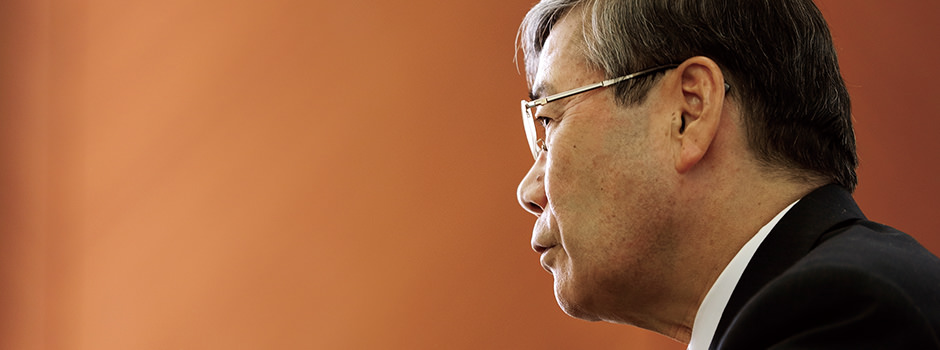
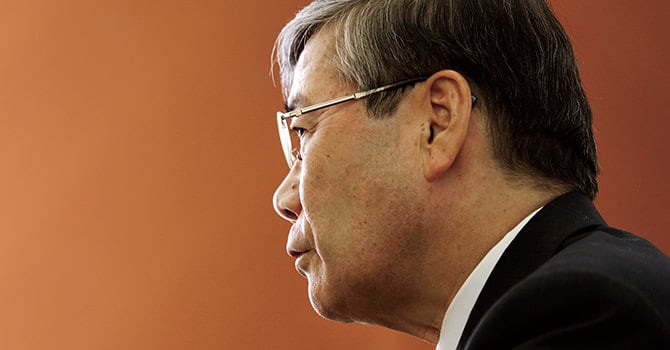
Two Businesses Hold the Key:
Within the 2018 Medium-Term Business Plan, two businesses will play especially critical roles: the MRJ and thermal power systems.
The MRJ business was placed under direct oversight by the CEO starting in fiscal 2016, and since that time the project has progressed according to schedule toward delivery of the first MRJ90—a 90-seat passenger jet—in fiscal 2020. One major hurdle that must be overcome is acquisition of type certification, i.e. safety authorization, and remaining issues and their solutions have now been clarified, making the outlook clearer than ever before. Going forward, development will continue to be accelerated and the MRJ business structure will be radically reinforced, including increasing the capitalization of Mitsubishi Aircraft Corporation, the entity in charge of the MRJ's development. Through restructuring to a business that can endure a prolonged development period—for example, by strengthening sales and customer support structures, shifting to full-scale development of the MRJ70, and reinforcing links with the commercial aircraft (Tier 1) business—our intention is to develop the MRJ business into a major pillar of our operations in the years ahead.
The thermal power systems business, sustained by a substantial order backlog, will continue to operate at full throttle through fiscal 2020. During that period we will continue to pursue enhanced profitability through efficient work performance, plant reorganization, reallocation of staff , and expansion of servicing operations. Simultaneously we will also focus on converting the business structure with a view toward the years beyond fiscal 2020. Through the years MHI, as a global frontrunner in the industry, has already made ongoing contributions to reducing environmental burdens by improving thermal power generation efficiency, developing CO2 recovery systems, etc. Going forward, in line with changing social needs—for example, the shift from fossil fuels to renewable energies and increased adoption of distributed power sources—we will build a new business model incorporating digitalization.
Reinforcement of Our Management Base:
In order for MHI to get on a growth trajectory, most important will be to take our attention to cash flow management and our fixed focus on earnings—outgrowths of the reforms we have carried out to date—and embed them into the deepest corners of all MHI Group companies both at home and abroad, thereby forming a new corporate culture. It may take some time, but it is imperative that we share this awareness and develop a corporate culture in which we can take up new challenges with confidence.
In terms of corporate structure, on the occasion of relocating to Tokyo's Marunouchi district in January 2019 we will establish a new global headquarters, marking the launch of a full-fledged global management structure. Already overseas sales account for more than half our annual net sales, and in the coming years the percentage is expected to increase further, making global response capability indispensable. The global headquarters will take charge of formulating all Company strategies and allocating management resources. Meanwhile the business segments/SBUs(NOTE2) and regional headquarters will implement management and strategies suited to the traits of their respective regions. In these ways, we will pursue robust growth while maintaining a good balance between global and local needs.
Additionally, we believe that developing and making excellent use of human resources to perform global management will also be of extreme importance. In this regard we will carry out various measures that will contribute to sustained growth: for example, developing human resources based on a medium- to longterm perspective, and appointing officers from a younger generation.
In 2004 MHI became a signatory to the UN Global Compact. In addition to carrying out its Ten Principles on human rights, labor, the environment, and prevention of corruption, in 2015 we formulated the “MHI Group Global Code of Conduct” indicating rules of behavior for all MHI Group employees to follow. Going forward, we will continue to conduct our business activities with sincerity and high ethical standards appropriate to a global company.
(NOTE2)SBU: Strategic Business Unit
Reinforcement of Global Operations
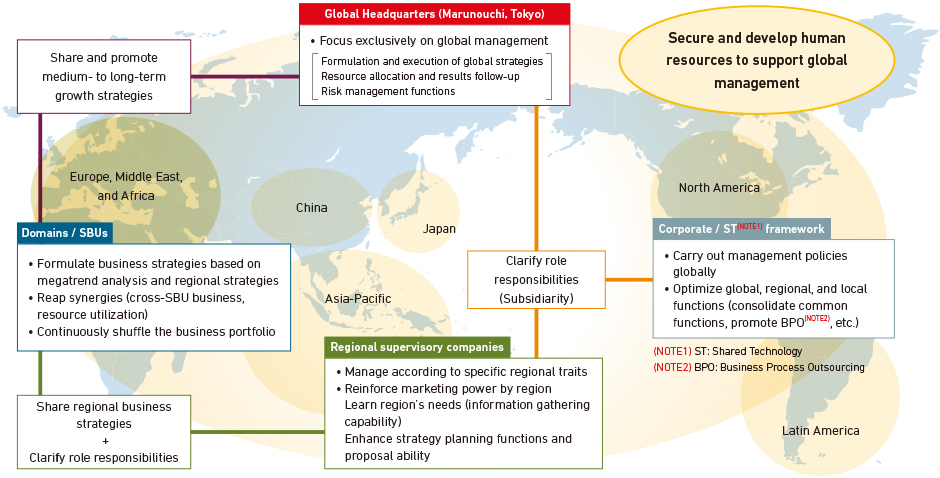
To Our Stakeholders:
To achieve TOP, the area requiring improvement most is our market value. Up to now we have used considerable time to respond to various challenges, but now that resolution of these issues is in sight, my determination is to win awareness by all our stakeholders that we have now entered a growth trajectory.
Of course, registering solid results is imperative. But at the same time, I hope to win the market's trust by fully and promptly explaining, to a degree never seen before, the situation we are in and the results we achieve.
As all members of MHI Group continue to reinvent themselves and strive toward their goals, I am confident we can become the entity we seek to be.
I humbly ask all our stakeholders to keep a close eye on MHI as we mark solid growth in the years ahead.
